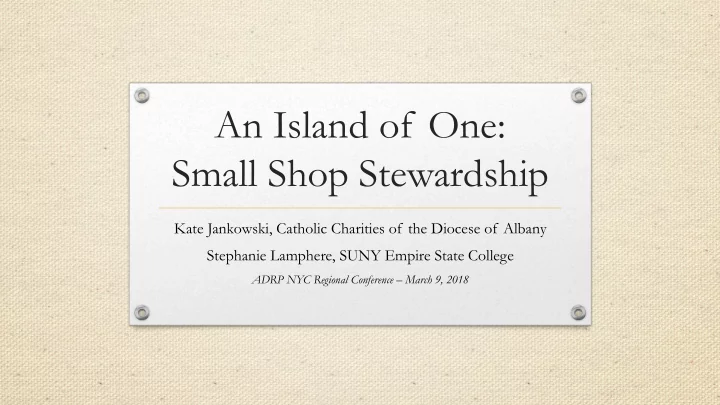

An Island of One: Small Shop Stewardship Kate Jankowski, Catholic Charities of the Diocese of Albany Stephanie Lamphere, SUNY Empire State College ADRP NYC Regional Conference – March 9, 2018
About Us Kate Jankowski Development Manager for Catholic Charities of the Diocese of Albany, a human services agency with a two-person development shop. Previously Director of Development for the League of Women Voters of New York State, the first and only member of the development staff. As Director of Stewardship and Donor Relations for Albany Medical Center, a private hospital and medical college, Kate was a member of a large development office. Stephanie Lamphere Associate Director of Development for Donor Relations at SUNY Empire State College, in a one-person shop. Previously served as Director of Special Events for The College of Saint Rose, in a two- person shop within a mid-sized development office. As a member of the Advancement Office and President’s Office at Skidmore College, Stephanie worked in small departments within a large advancement unit.
Defining a small shop
• Responsibilities - the four elements of Donor Relations: About You • Gift Acceptance and Management • Acknowledgement • Donor Recognition • Reporting • Size of Advancement Office • Reporting structure
Shops are Getting Smaller More than 1 in 4 people are • working in single-person Donor Relations shops. 35% of respondents have less • than 10 advancement staff. More than 30% have less than • a $10,000 budget for Donor Relations 75% of shops will stay the • same size or decrease in the next two years, only 25% plan to expand Courtesy of The Pulse of Donor Relations 2018 report, from the Donor Relations Guru, www.donorrelationsguru.com
Becoming your team’s MVP
Make Friends • Advancement Services • Alumni Affairs • Business Office • Facilities • Dining Services • Faculty Find a seat at the table!
Know Your Donors • Memorize your Trustee list • Attend local events – professional breakfasts, other nonprofit organizations’ fundraising events • Read the local paper Be a resource for your colleagues
Professional Development • Webinars – ADRP, Donor Relations Guru • Regional Organizations – Women in Development, Women@Work, Chamber of Commerce • Local colleagues – monthly get-togethers, make your own group • Conferences – CASE, ADRP, Academic Impressions Become an expert in the field
Getting it all done
Fitting it in around the edges Include a program update in a thank you letter. • Make a call to the donor when you enter their gift • to say thank you. Send on a story from a newsletter or make one of • your newsletter stories a donor relations piece. Use your annual report to tell donor stories. • Enlist willing Board members to help. • Any other creative way you can fit in donor • relations functions into your other duties!!
Streamline the Process • Templates for acknowledgements & regular correspondence • Draft copy for general use • Mail Merge and Excel spreadsheets are your friend • Set calendar reminders to plan ahead • Ask for help • Learn to let go!
Document, Document, Document • Write everything down • Nobody has the answers but you • Don’t make the same mistake twice • Plan for posterity
Output vs. Outcomes * • Output = the “stuff ” you create. E.g. scholarship reports, stewardship videos, endowment statements, annual reports • Outcomes = changes that result for your participants. E.g. students graduate with less debt, buildings are built, new programs created Understand your outcomes and demonstrate their impact. Don’t simply produce output. * From Michelle DiSabato, Blackbaud https://npengage.com/nonprofit-management/how-will-tracking-outcomes-help-your-organizations-story/
Evaluate Your Activities!!! When you decide on an activity, figure out why are you doing and what donor response you hope to achieve. Donor retention is a common goal and easy to measure. No. of donors who gave in years 1&2 / No. of donors who gave in year 1 x 100 = % Donor Retention Rate Good Resource: https://bloomerang.co/retention
Know Your Capacity “Imagine life as a game in which you are juggling some five balls in the air. You name them work, family, health, friends and spirit . And you're keeping all of these in the air. You will soon understand that work is a rubber ball. If you drop it, it will bounce back . But the other four balls — family, health, friends and spirit — are made of glass. If you drop one of these, they will be irrevocably scuffed, marked, nicked, damaged or even shattered. They will never be the same. You must understand that and strive for balance in your life.” - Bryan Dyson, President and CEO of Coca-Cola Enterprises, 1991 Keep balance & know when to say no
Knowing Your Capacity in a different way
Contact us! Kate W. Jankowski Stephanie Lamphere Development Manager Associate Director of Development Catholic Charities of the Diocese of Albany SUNY Empire State College 40 N. Main Ave 28 Union Avenue Albany, NY 12203 Saratoga Springs, NY 12866 (518) 641-6831 (518) 580-4965 Kate.Jankowski@ccrcda.org Stephanie.Lamphere@esc.edu
Recommend
More recommend